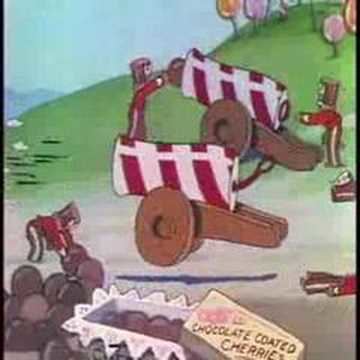The Hot Choc late Soldiers
7.2 /10 1 Votes
Country United States | 7/10 IMDb Duration Language English | |||||||||||||||||||||||||||||||||
 | ||||||||||||||||||||||||||||||||||
The hot choc late soldiers
The Hot Choc-late Soldiers, also stylized as The Hot Chocolate Soldiers, is an American animated short film that was made by Walt Disney Productions for MGM's 1934 film Hollywood Party, which released on 1 June 1934. It is prefaced in the film by a scene where Mickey Mouse appears at the party, performs a brief Durante impression, and then sits down at a piano, after which The Hot Choc-late Soldiers begins to play. Due to stipulations in the contract between Disney and MGM the short was edited out of the film when it was screened on TNT, however MGM was able to negotiate the licenses so that the footage was included in a 1992 VHS release of Hollywood Party and for subsequent releases.
Contents

The short contains no vocals other than a song performed by Don Wilson that describes the events of the cartoon.
Synopsis
A group of confectionery soldiers go to war against a neighboring cookie castle. As the army parade through the city streets, Chocolate Ladies and Soldiers' wives blow kisses to bid them goodbye. After multiple thwarted attempts to enter, the soldiers successfully conquer the fort defended by a troop of Gingerbread Soldiers by using a cunning Trojan Horse shaped like a large, candy-colored pigeon. The soldiers then take their Gingerbread prisoners to their city, but the sun beats down on the soldiers and melts them into a river of chocolate.
Production
In 1933 MGM contracted Disney to create a "'Silly Symphony' type" sequence for the film (then called Hollywood Revue). In the contract MGM stipulated that they wanted a sequence that was 400 feet in length and that they would pay Disney $64,000 ($80,000 if it was in technicolor) in four installments. The contract also stated that the short would not appear in 16 mm and television showings of the film and that Disney would create the musical score for the short, with MGM providing the musicians, sound effects, and recording equipment.
One of the short's original concepts was to focus on movie-star caricatures, which was dropped in favor of the song "Hot Choc-late Soldiers", which was written by MGM songwriters Nacio Herb Brown and Arthur Freed for the short. Despite the earlier contract, the soundtrack was recorded at Disney's studio. Animation for the film was overseen by Ben Sharpsteen, who guided a group of young artists that included Cy Young and Ugo D'Orsi. Production on the short occurred in the summer and fall of 1933 and a completed version of The Hot Choc-late Soldiers was sent to MGM in the beginning of November, only for the studio to return the short with a request to re-work the final scenes featuring the melted chocolate soldiers. The final version of the short was delivered to MGM on 22 January 1934.
The short is prefaced by a brief cameo by Mickey Mouse (who was voiced by Walt Disney himself), which was not initially intended to be included in the film but came about after a pitch for the character to appear in the 1933 film Meet the Baron was dropped. It represented Mickey's first actual appearance in a feature film, but was removed from the film upon its release to television. Mickey's appearance was intended to be used as a way to segue to the short, but the scene was subject to a series of re-writes as at this point in time Mickey Mouse shorts were built around "visual, rather than verbal, humor". The script went through so many re-writes that the scene's production took far less time to create than it did to write. Scriptwriting for the scene began in May 1933 and was completed around late September 1933. The completed scene was delivered to MGM in November 1933.
Reception
Much of the reception for The Hot Choc-late Soldiers focused upon its appearance in the film Hollywood Party. During Hollywood Party's initial release the short was seen as a highlight of a film that was largely panned by critics, a viewpoint shared by J. B. Kaufman and Roger Dooley. Critics like the City University of New York professor David Bakish and Velvet Light Trap's Allen Larson would later comment on how the appearance of Mickey and the introduction of the short felt abrupt and unintegrated with the rest of the film.
References
The Hot Choc-late Soldiers WikipediaThe Hot Choc-late Soldiers IMDb The Hot Choc-late Soldiers themoviedb.org
